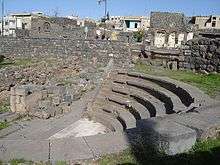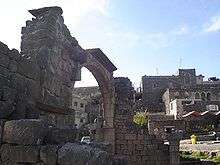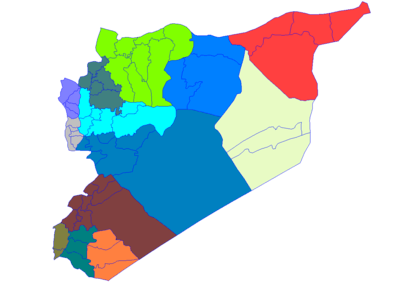As-Suwayda
| As-Suwayda السويداء | |
|---|---|
| City | |
 Suwayda's City aerial view October 2011 | |
 As-Suwayda Location of As-Suwayda within Syria | |
| Coordinates: 32°42′45″N 36°34′00″E / 32.71250°N 36.56667°ECoordinates: 32°42′45″N 36°34′00″E / 32.71250°N 36.56667°E | |
| Country |
|
| Governorate | As-Suwayda Governorate |
| District | As-Suwayda District |
| Elevation | 3,543 ft (1,080 m) |
| Population (2004 census[1]) | |
| • City | 73,641 |
| • Metro | 138,822 |
| Time zone | UTC+2 (EET) |
| • Summer (DST) | UTC+3 (EEST) |
| Area code(s) | 16 |
| Geocode | C6147 |
| Climate | Csa |
As-Suwayda (Arabic: السويداء / ALA-LC romanization: as-Suwaydā’, French: Soueïda or Sweida), also spelled Sweida or Swaida, is a mainly Druze city located in southwestern Syria, close to the border with Jordan.
It is the capital of As-Suwayda Governorate, one of Syria's 14 governorates, bordering Jordan in the South and Daraa Governorate in the West and Rif Dimashq Governorate in the north and east. The city is referred to by some as "Little Venezuela" due to the city's influx of affluent Venezuelan Syrians immigrants.[2][3][4][5]
Demographics and population
The inhabitants of the city are mainly Druze with a prominent Greek Orthodox Christians minority.
The population of As-Suwayda Governorate is 313,231 (2004 census). According to estimates from the Venezuelan Embassy in Damascus, almost 60% of the population of As-Suwayda was born in Venezuelan territory and possesses double nationality,[6][7][8] making the city referred to by some as Little Venezuela.
History

The city was founded by the Nabataeans as Suada. It became known as Dionysus (Ancient Greek: Διονῡσιάς) in the Hellenistic period and the Roman Empire, for the god Dionysus, patron of wine - the city is situated in a famous ancient wine-producing region.
The name Dionysus replaced the former Nabataean name of Suada in 149 AD after Nabataean influence decreased and then concentrated towards the south, as a result of the accelerating Hellenization of Coele-Syria at that time.


Dionysias was a part of the Roman province of Arabia Petraea, and received the rights of civitas under the reign of Commodus between 180–185.
Dionysus was worshipped in the same Nabatean temple dedicated for Dushara. This practice of associating the worship of local and Hellenic gods was common in Hellenistic Syria.
This name remained in use during the Byzantine Empire, when the town was under the influence of the Ghassanids, Dionysias then was a diocese with a suffragan bishop from Bosra. It was mentioned in the Synecdemus of Hierocles. After the early Muslim conquests it became a titular see.[9]
Yaqut al-Hamawi noted in the 1220s that As Suwaida was "a village of the Hauran Province".[10]
In recent times Dionysias was firstly identified as-Suwayda by William Waddington.
The city has been held by the government for the duration of the Syrian Civil War and has seen relatively little fighting. On 28 October 2012, security forces launched a campaign of mass arrests in the city.[11]
2018 As-Suwayda attacks
On July 25 2018 the city, which had been by that time far away from the front lines, was rocked by a string of terrorist attacks. A group of at least 56 ISIS-affiliated attackers entered the city and initiated a series of gunfights and suicide bombings on its streets killing at least 246 people the vast majority of them civilians. Many of the terrorists were liquidated during the attack, bringing the total death toll to at least 302 people. [12] Forty-two Druze ages 7 to 60 were kidnapped by ISIS and are being held captive. One has been executed bringing the total in captivity to 41. [13]
Archaeology
Many archeological sites could be found in the old part of the city:
- Temple of Dionysus-Dushara: eight well-decorated columns are still standing from the temple.
- Saint Sergius Basilica: was built in the fifth century. It has Byzantine architectural elements, with an abbey surrounding it. The basilica was dedicated to Sergius.
- The arch of the lesser church: the church itself is ruined. An arch is still standing there known locally as "The Gallows" (Arabic: المشنقة al-Mashnaqah) with grape motif decorations.
- The amphitheater: was recently discovered, south of the Agora.
The city has many ancient reservoirs, towers and old Roman houses that are still inhabited by locals.
Many parts of the old city are still to be excavated, such as the Roman aqueduct, a conical reservoir, and a larger Roman amphitheater.
Climate
As Suwayda's climate is classified as warm and temperate. There is more rainfall in the winter than in the summer in As Suwayda. This location is classified as Csa by Köppen and Geiger. The average temperature in As Suwayda is 15.5 °C. About 323 mm of precipitation falls annually.
| Climate data for As-Suwayda | |||||||||||||
|---|---|---|---|---|---|---|---|---|---|---|---|---|---|
| Month | Jan | Feb | Mar | Apr | May | Jun | Jul | Aug | Sep | Oct | Nov | Dec | Year |
| Average high °C (°F) | 10.5 (50.9) |
11.7 (53.1) |
15.2 (59.4) |
20.1 (68.2) |
25.4 (77.7) |
29.2 (84.6) |
30.1 (86.2) |
30.9 (87.6) |
29.2 (84.6) |
26.0 (78.8) |
19.1 (66.4) |
12.8 (55) |
21.7 (71) |
| Daily mean °C (°F) | 6.2 (43.2) |
7.1 (44.8) |
10.0 (50) |
13.9 (57) |
18.3 (64.9) |
21.7 (71.1) |
22.8 (73) |
23.5 (74.3) |
21.8 (71.2) |
18.9 (66) |
13.6 (56.5) |
8.3 (46.9) |
15.5 (59.9) |
| Average low °C (°F) | 1.9 (35.4) |
2.6 (36.7) |
4.8 (40.6) |
7.8 (46) |
11.3 (52.3) |
14.2 (57.6) |
15.6 (60.1) |
16.1 (61) |
14.4 (57.9) |
11.8 (53.2) |
8.1 (46.6) |
3.9 (39) |
9.4 (48.9) |
| Average precipitation mm (inches) | 69 (2.72) |
71 (2.8) |
57 (2.24) |
21 (0.83) |
8 (0.31) |
0 (0) |
0 (0) |
0 (0) |
1 (0.04) |
11 (0.43) |
27 (1.06) |
58 (2.28) |
323 (12.71) |
| Source: Climate-Data.org[14] | |||||||||||||
References
- ↑ http://www.cbssyr.org/new%20web%20site/General_census/census_2004/NH/TAB13-1-2004.htm%5Bpermanent+dead+link%5D
- ↑ http://newsfromsyria.com/2009/09/04/hugo-chavez-in-syria/ Many of them came from Sweida. So when their descendants returned, they brought back the Spanish language and South American culture. Sweida is little Venezuela.
- ↑ http://www.economist.com/node/16276817 Dubbed “Little Venezuela”, the southern Syrian town of Sweida offers arepa bread, roads named after Latin American revolutionary leaders and visits from Venezuela's president, Hugo Chávez. It has long been known for its Hispanic influence, thanks to generations of Syrians and Lebanese who left in the 19th and 20th centuries to work in South America and who have periodically returned.
- ↑ https://books.google.co.ve/books?id=sTv_xhnIKCwC&pg=PP193&lpg=PP193&dq=syrians+in+venezuela&source=bl&ots=OJ1SvfLlN2&sig=zJC2LZ3ydi-sfKDEdydkSzABCJo&hl=es-419&sa=X&ved=0ahUKEwjnhLz5wcLRAhXmgFQKHeg_Abg4FBDoAQglMAI#v=onepage&q=syrians%20in%20venezuela&f=false And the Syrian town of Sweida is known as "Little Venezuela"
- ↑ http://www.gettyimages.ae/detail/news-photo/an-elderly-syrian-man-waves-venezuelas-flag-during-a-visit-news-photo/90340575#an-elderly-syrian-man-waves-venezuelas-flag-during-a-visit-by-hugo-picture-id90340575 Chavez visited Sweida, homeland of many of Venezuela's million strong Syrian community
- ↑ http://distintaslatitudes.net/el-levante-y-america-latina-arabe-con-acento-espanol-una-bitacora-de-latinoamerica-en-siria-libano-jordania-y-palestina Around 60% of the population of Sweida was born in Venezuelan territory (spanish article)
- ↑ http://www.26sep.net/news_details.php?lng=english&sid=56858 More than 200,000 people from the Sweida area carry Venezuelan citizenship and most are members of Syria's Druse sect, who immigrated to Venezuela in the past century.
- ↑ https://www.aporrea.org/internacionales/n298431.html As-Suwayda the province with the most citizens of Venezuelan-Syrian origin
- ↑ "Catholic Encyclopedia: Dionysias". Newadvent.org. 1909-05-01. Retrieved 2014-06-20.
- ↑ quoted in le Strange, 1890, p. 540
- ↑ "At least 30 people killed in clashes, most of them in Damascus". Al Jazeera Blogs. Retrieved 25 October 2014.
- ↑ https://www.usnews.com/news/world/articles/2018-07-26/death-toll-in-devastating-is-attacks-in-syria-climbs-to-216
- ↑ https://ewn.co.za/2018/08/05/islamic-state-in-syria-executes-hostage-from-sweida-attack-media-monitor
- ↑ "Climate: As Suwayda". Retrieved 2016-02-27.
Bibliography
External links
- Map of the town, Google Maps
